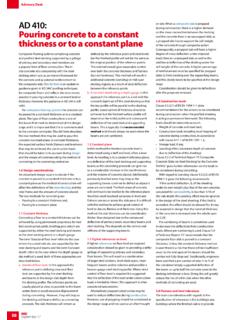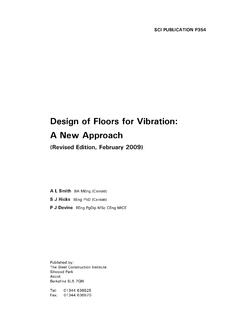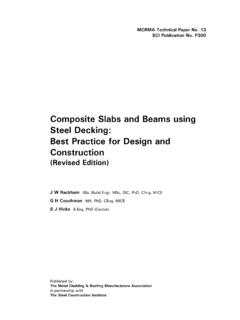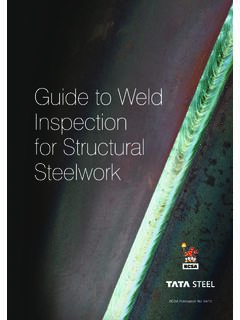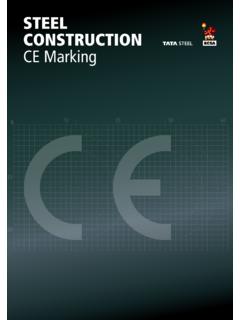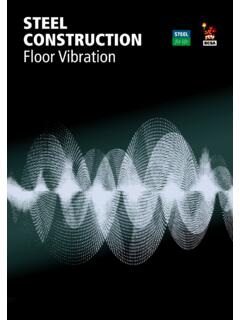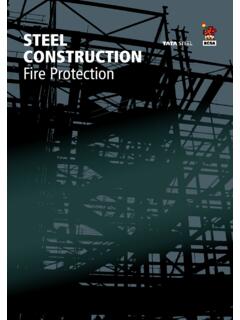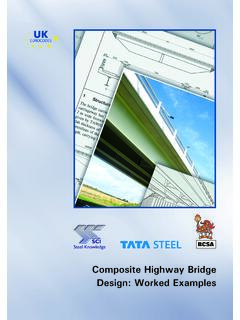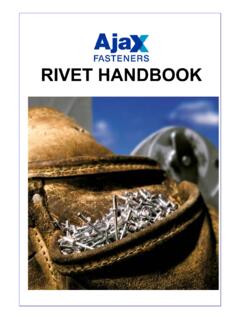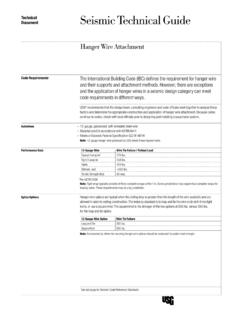Transcription of Design Guide for Steel Railway Bridges - Steel Construction
1 SCI PUBLICATION P318 Design Guide for Steel Railway Bridges D C ILES MSc ACGI DIC CEng MICE Published by: The Steel Construction Institute Silwood Park Ascot Berkshire SL5 7QN Tel: 01344 623345 Fax: 01344 622944 P:\PUB\PUB800\SIGN_OFF\P318\ ii 2004 The Steel Construction Institute Apart from any fair dealing for the purposes of research or private study or criticism or review, as permitted under theCopyright Designs and Patents Act, 1988, this publication may not be reproduced, stored or transmitted, in any form or byany means, without the prior permission in writing of the publishers, or in the case of reprographic reproduction only inaccordance with the terms of the licences issued by the UK Copyright Licensing Agency, or in accordance with the termsof licences issued by the appropriate Reproduction Rights Organisation outside the UK. Enquiries concerning reproduction outside the terms stated here should be sent to the publishers, The Steel ConstructionInstitute, at the address given on the title page.
2 Although care has been taken to ensure, to the best of our knowledge, that all data and information contained herein areaccurate to the extent that they relate to either matters of fact or accepted practice or matters of opinion at the time ofpublication, The Steel Construction Institute, the authors and the reviewers assume no responsibility for any errors in ormisinterpretations of such data and/or information or any loss or damage arising from or related to their use. Publications supplied to the Members of the Institute at a discount are not for resale by them. Publication Number: SCI P318 ISBN 1 85942 150 4 British Library Cataloguing-in-Publication Data. A catalogue record for this book is available from the British Library. P:\PUB\PUB800\SIGN_OFF\P318\ iii FOREWORD This publication has been prepared to provide a comprehensive yet relatively concise introduction to the Design of Steel and composite Railway Bridges , with particular reference to Design in accordance with BS 5400 Design of Steel concrete and composite Bridges .
3 The publication has been prepared by Mr D C Iles (The Steel Construction Institute), based on a number of substantial contributions from practising senior engineers and with the assistance of an Editorial Advisory Group. The main contributions were made by the following companies: Atkins Rail Corus Rail Consultancy Scott Wilson Railways Network Rail Fairfield Mabey Ltd Guidance in drafting Sections 6, 7 and 8 was provided by Mott MacDonald. The worked example of a U-frame bridge is based on an example provided by Cass Hayward and Partners. The SCI is very grateful to these companies for their contributions. The Editorial Advisory Group comprised the following members: Mr J Bleasdale Metronet Rail SSL Ltd Mr I K Bucknall Network Rail Mr A C G Hayward Cass Hayward and Partners Mr W Heggie Scott Wilson Railways Mr R Molloy Atkins Rail The SCI wishes to express thanks to the members of the editorial group for their assistance and advice in the preparation of this publication.
4 Thanks are also expressed to Mr D Merrett, Corus Rail Consultancy, who provided valuable comment in the latter stages of drafting. The work leading to this publication was funded by Corus Construction and Industrial and by Network Rail. P:\PUB\PUB800\SIGN_OFF\P318\ iv P:\PUB\PUB800\SIGN_OFF\P318\ v CONTENTS Page No. FOREWORD iii SUMMARY vii 1 INTRODUCTION 1 2 FUNCTIONAL REQUIREMENTS 3 Key functional requirements 3 The Railway infrastructure 3 Strength and fatigue endurance 9 Bridge deformation 10 Robustness 11 Durability 12 Clearances from the Railway 13 Underline clearances 21 3 Construction REQUIREMENTS 22 General 22 Minimising disruption to the operational Railway 22 General site constraints 24 Third party issues
5 25 Methods of bridge erection 25 Replacement of the permanent way 30 Buildability 30 4 FORMS OF Construction 33 Influences on form of Construction 33 Shallow deck-type Bridges 34 Half through plate girder Bridges 36 Standard box girder Bridges 42 Slab-on-beam composite girder Bridges 44 Truss girder Bridges 45 Direct fastening Construction 46 Integral Construction 47 5 Design STANDARDS 49 HMRI principles and guidance 49 Railway standards 49 Technical approval 50 Particular Railway standards 50 BS 5400 51 Design Manual for Roads and Bridges 53 Matters not covered by standards 53 Development of Standards 54 6 Design PROCEDURES 55 General 55 Design basis 56 Loading 57 Initial Design 63 Global analysis 66 P.
6 \PUB\PUB800\SIGN_OFF\P318\ vi Detailed Design 70 Design of half through Bridges 70 7 Design FOR STRENGTH 72 General 72 Design resistance of beams without longitudinal stiffeners 78 Filler beams 82 Restraint systems 83 Material strength and notch toughness 85 Slab Design 87 Interfaces with substructures 88 Bearings 88 8 Design FOR FATIGUE ENDURANCE 90 General 90 Methods of assessment 90 Fatigue loading 91 Classification of details 91 Limiting stress range 92 Considerations for particular details 92 9 Design FOR DEFORMATION PERFORMANCE 95 General 95 Deflection under permanent loads 95 Deformation due to rail loading 95 Deformation due to rail loading and temperature 97 Lateral deformation 98 Effect of deformation on clearances 98 10 BRIDGE DETAILS 99 Shallow deck-type Bridges 99 Half through plate girder Bridges 100 Standard box girder Bridges 116 Slab-on-beam composite girder Bridges 116 Bearing details 116 Deck end waterproofing details 117 Footways 118 11 REFERENCES 120 Appendix A Steel BRIDGE GROUP GUIDANCE NOTES 125 Appendix B WORKED EXAMPLE 127 P:\PUB\PUB800\SIGN_OFF\P318\ vii SUMMARY This Guide offers an introduction to the Design of Steel and composite Railway Bridges .
7 It presents a review of the particular requirements for carrying Railway traffic and interfacing with Railway infrastructure and, since Construction issues are particularly acute for replacement Bridges , describes the constraints and options for Construction . Typical forms of Construction for short to medium span Bridges are described and simplified cross sectional arrangements are illustrated. A key consideration for the selection of Railway Bridges is a safe and reliable structure that can be constructed and maintained with minimal disruption to Railway passengers and traffic Steel Railway Bridges meet these requirements particularly well. The Guide explains that Design of Railway Bridges in the UK is governed not only by BS 5400 but also by the comprehensive additional requirements of the Railway authorities, notably Network Rail.
8 Design procedures are described and detailed aspects of Design for strength, for fatigue endurance and for deformation performance are discussed. A range of typical details is illustrated, with comments about the factors that need to be considered when selecting and designing them. A worked example of a single span half through bridge with a composite deck carrying two tracks is presented. It illustrates the main features in determining the appropriate bridge details and in verifying the adequacy of the bridge. P:\PUB\PUB800\SIGN_OFF\P318\ viii P:\PUB\PUB800\SIGN_OFF\P318\ 1 1 INTRODUCTION Steel has been used in the Construction of Railway Bridges since Victorian times, both in major long-span structures and in more modest spans, such as over local highways. Many of these older Steel Bridges are still in service, thanks to an on-going programme of maintenance, refurbishment and upgrading to suit changing requirements.
9 Today, most Railway Bridges are built as replacements for earlier structures, although some entirely new structures are being built on new alignments or routes, most notably for the Channel Tunnel Rail Link. For replacement Bridges , Steel Construction can achieve shallow Construction depths, which is essential where the track level is fixed yet sufficient underline clearance is needed for highways or other services below the bridge. Steel Construction is suited to prefabrication and preassembly and, because of its relatively modest self weight, can be transported or lifted into position in the very short periods during which the Railway can be closed to traffic. For Bridges on new alignments, where there is greater freedom with the vertical profile of the route, greater Construction depths can be used and this opens up the possibility of the use of slab-on-beam composite Construction , in a form similar to that favoured for highway Bridges .
10 This Guide offers an introduction to the Design of Steel and composite Railway Bridges , for readers who are generally familiar with the principles of limit state Design . Some experience of bridge Design , perhaps of the Design of highway Bridges , would be advantageous in understanding the detailed Design procedures. The Guide begins with a review of the particular requirements for carrying Railway traffic and interfacing with Railway infrastructure. Since Construction issues are particularly acute for replacement Bridges , because of the need to minimise disruption to users of the Railway , guidance is given on the constraints and options for Construction . So-called standard bridge types were developed by British Rail from the 1950s onwards and although there is currently only one true standard bridge type in common use, features of many of the others are still appropriate.
